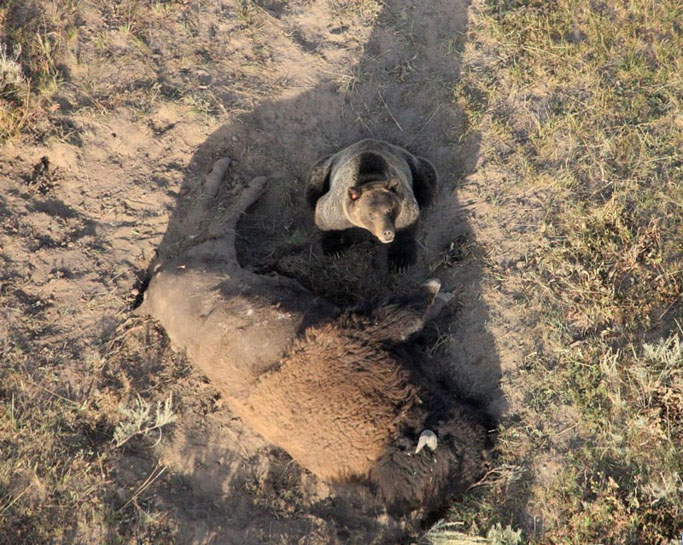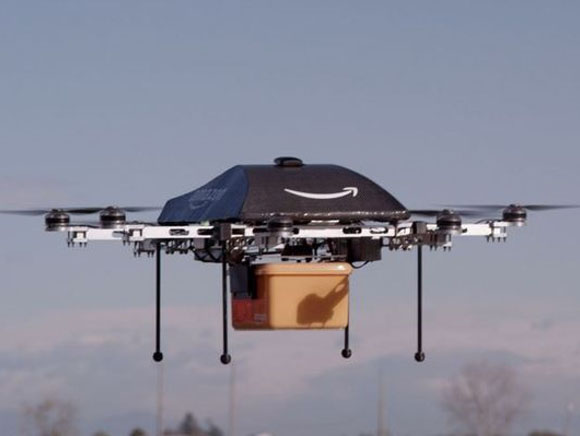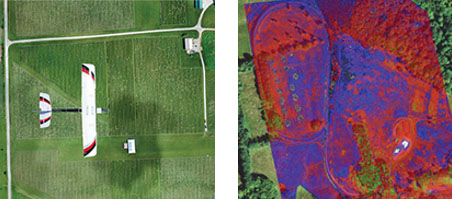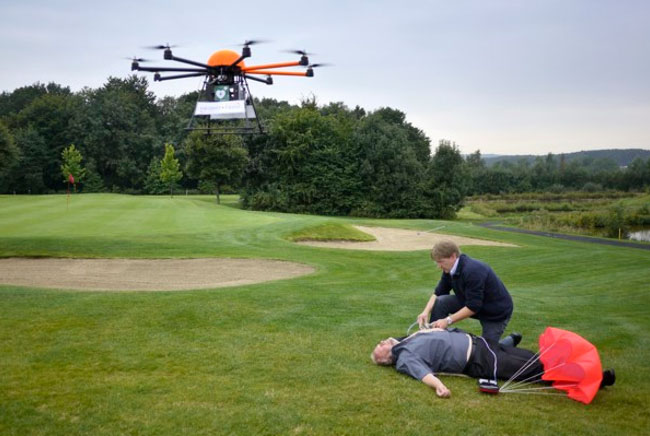A few weeks ago, I was sitting peacefully on the shore of the Cline River Reservoir near David Thomson Park watching the sunset (and actually enjoying the fact that there was no cell phone coverage in this particular part of the world) when the silence of the moment was disturbed by what sounded like a swarm of about a million angry hornets buzzing overhead. A family down the beach had just launched a high-end drone, and for the next half hour I had to put up with the sound and distraction of this drone zipping back and forth above me.
As the peaceful silence of my sunset watching was clearly ruined for the moment, with the distraction of this drone flying overhead, I decided to inquire further and learn more about this device. I approached the father, who was at the controls, and asked him for some more details about his fancy drone. He said it cost about $1500 and had a range of about 2km. The controller had a wireless video feed from the high-definition camera onboard the drone to an iPad that was plugged into the controller. The drone could climb from ground level to several hundred feet overhead in a matter of seconds and had a battery that would last about a half hour. It also had a control system that allows the drone to hover in place and automatically compensate for any cross winds or down drafts, making it very easy to fly and control without needing continuous user input. There was clearly a lot of technological capability packed into this small device and it was all available at a reasonably affordable price point. I returned to my rock where I was sitting before to watch the rest of the sunset and paused to reflect on how interesting it was to watch the speed and power of this technological marvel in action. (Though I have to admit that some part of me was secretly hoping that I would be able to witness it crash into the lake or a tree, so I could go back to the peace and quiet of the natural setting.)
I am always reminded of the rapid rate of change in technology when I think back to the so called high-tech devices that we used to have, even five or ten years ago. Watching this drone in action certainly illustrated this point. Around the time when my first child was born, which was bit more than 10 years ago, I purchased a camcorder that offered standard definition video, the batteries lasted about a half hour and I had to change the tapes when I ran out of space to record… (Videos stored on tapes! Remember those days?) And what did this camcorder cost? About $1500 at the time. And if I wanted it to fly, about all I could do was throw it up in the air and catch it, tape it to a pole, or perhaps charter a private helicopter and take it with me up in the air for a few thousand dollars per hour of helicopter flight time.
Drones - Useful or frightening?
The topic of drones has come up more and more in conversation with friends and family over the past summer and the opinions are wide ranging. Most people don’t like the fact that it is a new way for people to film you from a distance and feel that it is a potential invasion of privacy. I have to admit that during that recent experience at the lake I did feel a bit uncomfortable, as the drone flew by with its onboard camera pointed in my direction. Not that I had anything to hide at the time, it was just a bit of a creepy feeling knowing that you were being filmed from a distance and there was nothing that you could do about it. At least I was well aware that I was being filmed. With the noise that these drones make, it would be hard for anyone not to notice a drone flying overhead.
If you really wanted to film someone in their backyard you could just tape an iPhone or GoPro to a broomstick and it would be totally silent. Not that I have any intention of spying on anyone, I am just pointing out that if someone actually really wanted to spy on you, the technology has already been in existence for decades and doesn’t necessarily involve drones or anything really high-tech or clever for that matter. Fortunately, I don’t have anything going on in my life that is so interesting that I am particularly worried about being spied on by anyone.
The natural reaction for most people when a new and disruptive technology comes on the market is to blame the technology for any negative things that happen. For every new technology there are almost always both good and bad uses for it. We have to remember that it is the users of technology that are really the issue. As a simple example, before guns there were bow and arrows, spears, clubs, rocks and so on. Each one made hunting and gathering food easier, but these weapons could obviously be used against people too. Examples of technologies that are both helpful and harmful or destructive have been demonstrated throughout history. Nuclear weapons vs. nuclear power, fighter jets vs passenger jets, spy satellites vs communications satellites etc.
On the helpful side of things, drones can capture incredible images of wildlife, nature or events that were not easily available before. They can also deliver lifesaving devices, packages or other useful items to remote areas very quickly. They can be mustered nearly instantly in an emergency from almost any launch point, unlike an aircraft that requires far more time to mobilize.
Videos and photos have been captured of grizzly bears, whales and other wildlife from only a few metres above them. It is fascinating to view wildlife this close and the footage provides an incredibly detailed view of nature. I’m not sure what a grizzly bear thinks of having a drone buzzing overhead, but from the footage I have seen they seem to mostly just ignore it after a few minutes. (Although I would like to see footage of a drone getting close enough to the point where the bear swats it out of the air. I’m sure that will happen at some point, and the video will go viral on the internet.) Images like the one below of a bear guarding its kill give biologists an even more detailed look at how animals live and potentially provide better information to study them and protect their habitat.

Photo: ZME Science
For every useful and constructive application there seems to be an offsetting negative application. For example, wildlife officers could use drones to track endangered species or even for surveillance against poachers. At the same time, poachers could use their own drones to track the movements of wildlife and even the wildlife officers that they are trying to keep away from.
The internet giant Amazon is currently testing drones for package delivery. The company’s goal is to eventually have the capability to deliver a package weighing up to five pounds to your door within a half hour. This is basically as fast as ordering a pizza. They claim that a five pound payload limit would cover over 80% of the products that they sell. This seems like an interesting concept, but do we really need that package on your doorstep within half an hour from the Amazon warehouse? Can’t we wait for next day delivery on the UPS truck anymore? I suppose if you forgot to buy a birthday present for one of your children, having that latest popular toy show up in minutes could be a saviour in this type of situation. Medications could be delivered from pharmacies to people who are housebound. If you needed a new pair of shoes or a tie to match your outfit for an evening out you could have the latest fashion in your hands in minutes. The company admits that it will likely be four or five years before we see this plan implemented. The technology is still in early stages of development and implementation of this plan will also need to overcome significant regulatory hurdles.

Photo: Amazon.com
Farmers now have the ability to purchase a drone with moisture sensors to fly over their crops and optimize their irrigation systems and monitor their crops. High resolution images using sensors to detect different wavelengths of light can also detect early signs of fungus, pests or other harmful problems that can arise before they can be detected with the human eye. In the past, crop imaging with a manned aircraft could cost upwards of $1000 per hour of flight time. Now farmers can purchase entire drones with rechargeable batteries outright for around the same cost as one or two hours of flight time and fly them as much as they want for essentially no cost, other than the small amount of electricity it takes to charge the batteries. These drones have the capability to automatically image an entire field using GPS navigation and return to the launch point on their own without any human input. The images can be analysed by computers in the cloud and the end result is useful data that can be used by farmers to produce higher crop yields, lower water consumption and lower pesticide and fertilizer use.

The MIT technology review recently published an entire article on the topic of drones in agriculture.
Aside from aerial videos and package delivery there are some potentially lifesaving applications for drones like delivering an AED (Automatic External Defibrillator) to a heart attack victim in a remote area. While defibrillators are becoming more and more prevalent at golf courses and large events, a significant amount of time could be saved if the AED could reach the victim on the back 9 holes in a few minutes. The same type of system could be used to drop a life ring to someone drowning in the ocean.

Photo: The Verge
On the potential negative side of things drones could easily be adapted for more destructive purposes. There is video footage on YouTube of some drunken partyers taping Roman candle fireworks to a drone and chasing their friends around in the snow while the drone shoots the Roman candle fireballs at them like a mini attack helicopter. The footage makes for a good laugh at their expense, but it doesn’t take a huge mental leap to think of what other shooting devices could be attached to a drone for a more lethal purpose.
If Amazon can deliver a package from the sky and land it on your doorstep from miles away, could the same technology be used by criminals or terrorists to drop something other than your latest purchase on your doorstep? (I’m not trying to scare everyone, but I’m sure that I’m not the first person to think of this.)
While scenarios like these are somewhat frightening, we have to keep in perspective that people have always had the ability to do lots of nasty things before drones became as prevalent as they are now and fortunately this type of thing rarely happens in civil society.
During the recent wildfires in British Columbia and the North Western United States, eight firefighting helicopters were grounded because someone had launched a drone in the area of the flight path where they were fighting the fire. Presumably, the user didn’t intend to bring the entire firefighting operation to a stop with their actions, but was simply looking to get some interesting aerial footage of the fires. The public does need to be educated on how to use drones safely and responsibly and reminded how easily they can interfere with other aircraft.
One other recent news article involving drones, where I won’t give the user the benefit of the doubt, took place last weekend at the U.S. Open tennis tournament in New York. The headline read something like ‘Teacher arrested after drone crashes into stadium’. I don’t think anyone could conceive of a defence as to why they thought it was a good idea to fly a drone above a crowded tennis stadium during a live match. Play was briefly stopped while security investigated the situation. The article went on to discuss how the laws are still catching up with how to regulate the use of drones.
As with any new technology, there will always be a wide variety of reactions from the public when it is introduced. The initial knee jerk reaction will subside as people get used to drones becoming more prevalent in their day to day lives. There seems to be a push to regulate drones or ban their use within cities, but realistically the technology is now well established, and there is no way to put it back in the box, so to speak. At this point is seems that the laws and regulations are still catching up to the technology as we hear news clips of drones interfering with commercial flights, crashing into populated areas and causing other unforeseen problems. Though as we all know, simply regulating a technology or activity doesn’t necessarily stop it from happening. We have laws against drunk driving and unfortunately, this type of behaviour still happens. Aside from the applications mentioned here people will find other new and interesting things to do with drones that we have never thought of or anticipated. Hopefully we find more useful and productive applications than negative or harmful ones.
This material is provided for general information and is not to be construed as an offer or solicitation for the sale or purchase of securities. Neither the author or Richardson GMP Limited makes any representation or warranty, expressed or implied, in respect thereof, or takes any responsibility for any errors or omissions which may be contained herein or accepts any liability whatsoever for reliance on this report or its contents. Richardson GMP Limited, Member Canadian Investor Protection Fund. Richardson is a trade-mark of James Richardson & Sons, Limited. GMP is a registered trade-mark of GMP Securities L.P. Both used under license by Richardson GMP Limited.